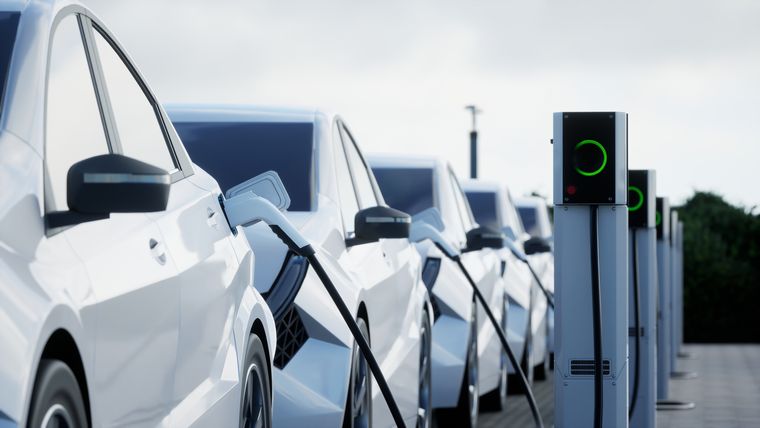Electric vehicle marketing
Unlocking behaviour of electric vehicle owners and opportunities for EV marketers

Imagine people widely using smartphones and laptops in the 1980s, colour TVs in the 1950s, or motor cars in the early 1900s. These technologies were regarded as futuristic concepts at first, but eventually became a way of life.
Similarly, the idea of operating a vehicle using electricity was conceived in the 19th century. Unfortunately, the concept did not progress beyond just being an amusement or as they say a parlour trick—“Look! No horse or ox, yet it moves!’’ Yet, after several ups and downs, when electric vehicles (EVs) subsequently entered the automobile market as an alternative to internal combustion engine vehicles (ICEVs), they failed to penetrate the market due to multiple reasons.
With rising fuel prices and environmental concerns over the last few years, the automobile industry witnessed the return of EVs (electric vehicles) by new entrants such as Tesla painting a unique picture for the automobile sector with their high-performance EVs that use advanced technology.
This led to a disruption in the automobile sector causing dominant automobile brands to rethink their strategy and evolve. But the big question is, has the industry and brands been able to address the consumer concerns associated with EV adoption?
Hence, Borderless Access conducted a study across 13 markets to unlock the evolving behaviour, brand preferences, and factors influencing the attitudes and perceptions of EV owners. The insights here would also highlight the opportunities for brand marketers and how they can help drive EV adoption to gain a bigger market share for their brand.
EVs are now more than just a “cleaner vehicle’’
EVs have always been a smart environmental choice, and it is one of the top reasons for existing EV owners to choose an EV over a fuel guzzler, and a sizable proportion of respondents are considering purchasing one, with 67% stating that they believe faster EV adoption will help slow down global warming.
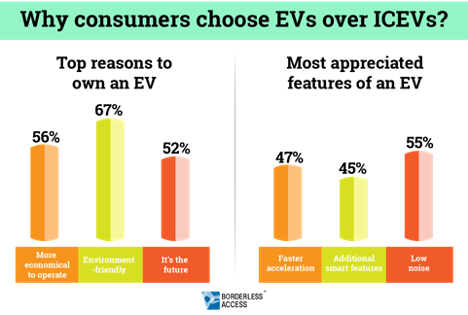
NOTE: Each bar on the graphs represents global data of the associated survey question.
Another common reason for owning an EV is its low operating cost, which is a significant purchase factor for a large number of existing EVs.
It is common knowledge among EV enthusiasts that EVs are more economical to operate and maintain than ICEVs. EV sceptics, on the other hand, will point to the premium pricing of many EVs. So, are EVs truly less expensive to own in the long run?
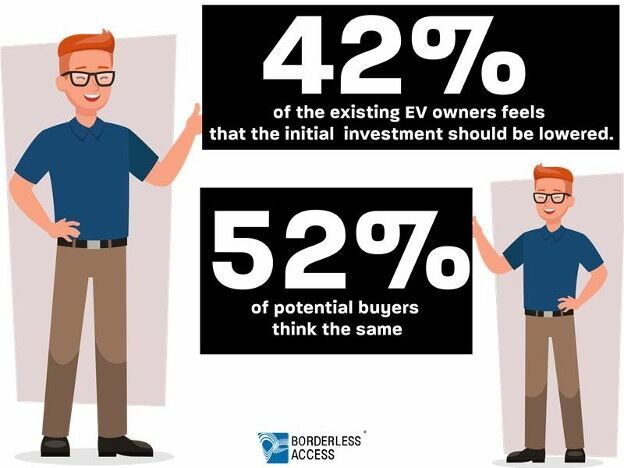
EVs are not only environmentally friendly, existing owners find EVs to be more comfortable with better ride quality and fast acceleration.
EV owners demand better-charging infrastructure
Among the factors influencing EV satisfaction, range—the distance the vehicle can travel on a single charge—is crucial.
Access to efficient charging stations is not only a concern for potential EV buyers, but it also has an impact on the level of satisfaction of existing owners.
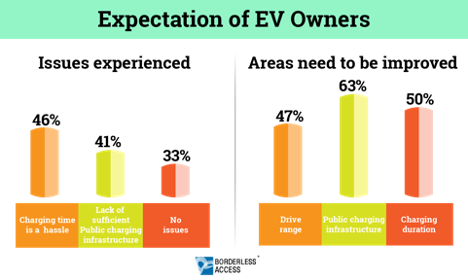
NOTE: Each bar on the graphs represents global data of the associated survey question.
Charging infrastructure remains a paramount concern due to inadequate number of charging stations and long charging times causing range anxiety, influencing the purchase decisions of consumers.
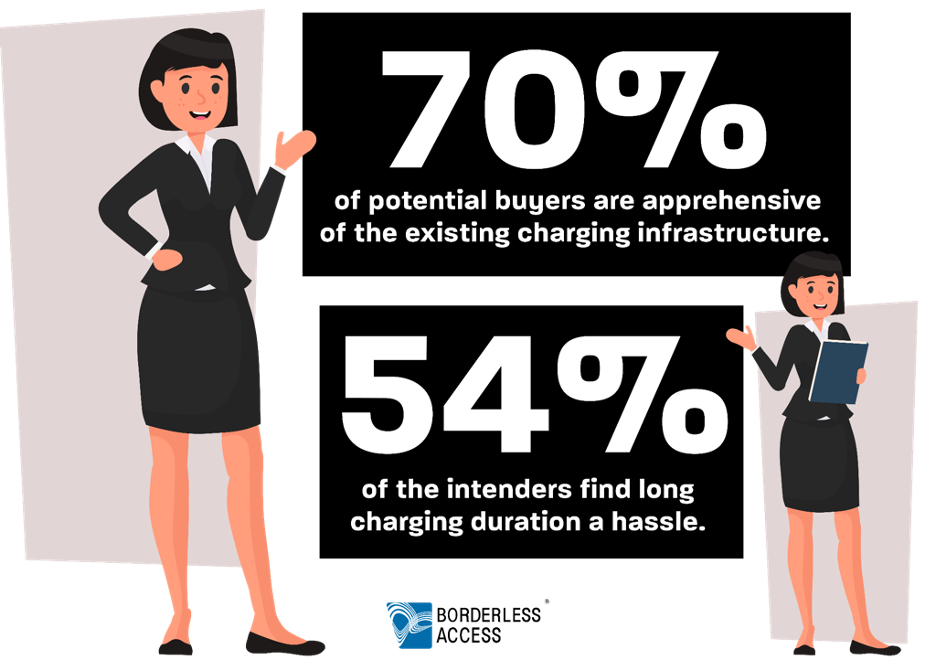
36% of EV owners will consider an upgraded version only if it offers more drive range while 49% of the potential consumers will make a purchase decision based on the range offered.
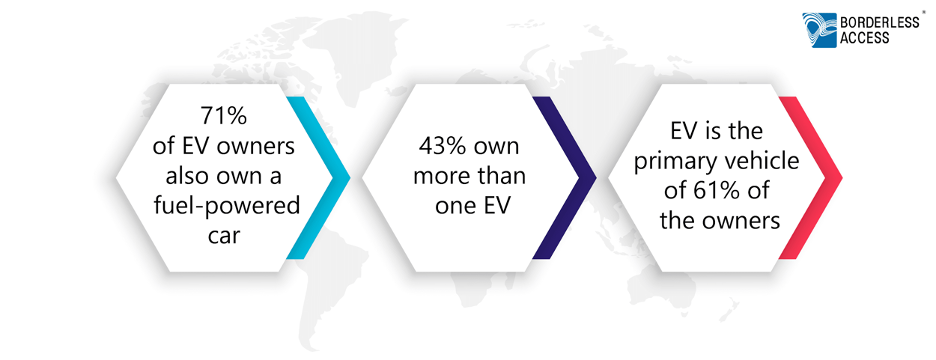
A majority of EV owners also own a fuel-powered car due to the concerns stated earlier, but, does that imply that consumers are more likely to use their ICEV in case of an emergency?
Possibly, yes.
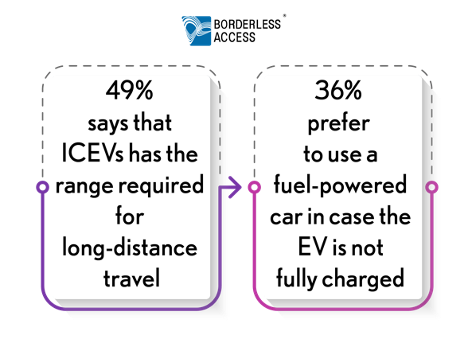
Type of cars owned and brand preferences
Sedans followed by SUVs are the popular choice of EV’s owned by consumers.
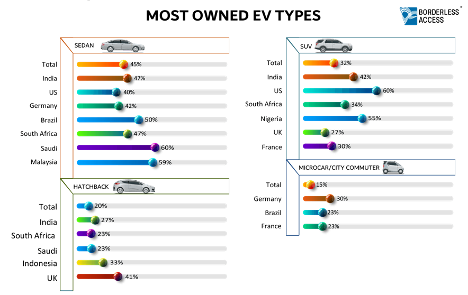
When it comes to preferred brands, Tesla, the brand that more or less disrupted the EV market segment, is not at the top of the list. It is not surprising at all. Tesla offers a greater driving range, more power, and incredible acceleration for an EV, but it comes with a premium price due to its broad differentiation strategy. Though Tesla has rolled out its low-priced range EVs, there are now other established and new brands that are luring potential buyers with their high-performance and feature-rich EVs at better price points.
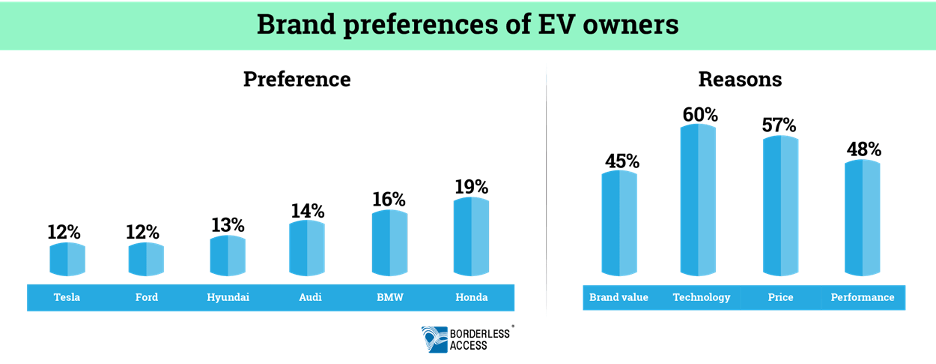
NOTE: Each bar on the graphs represents global data of the associated survey question.
Opportunity for EV Marketers
It is true that the movement towards cleaner vehicles has been a driving force in reshaping the EV market, and word-of-mouth has played a significant role.

NOTE: Each bar on the graphs represents global data of the associated survey question.
While making an expensive purchase, buyers mostly rely on the opinion of existing owners or users. In the case of EVs, there are already several concerns about cost and convenience, hence, real-time feedback from friends and family appears reliable. This gives brand marketers a great indirect marketing and sales team in the form of existing owners (95%) who are inclined to encourage non-EV owners to switch to electric vehicles. However, if the product does not meet the needs of the existing owners or creates a negative experience, then this can work against the brand, hence it's important for marketers to create fantastic experiences for their consumers at every touchpoint.
Almost at par with word of mouth, the next big medium driving awareness and influencing the purchase decisions are ‘social media and digital ads’. A compelling ad instigates the thought of considering the product and then a potential buyer goes to peers for recommendations and existing consumers for feedback. Social and digital media has played a crucial role in promoting EVs as a cleaner alternative and marketers have well-used this agenda to place the product.
Automobile review sites have been another excellent way to get more mind share.
Not surprisingly, ATL mediums—TV and Print—have been ranked low as a purchase influencer for EV’s due to its niche segmentation and TG that requires targeted BTL marketing avenues to create AIDA (Awareness, Interest, Desire, Action) for influencing consumer purchase decisions.
Future - Will EVs take over the automobile industry?
EVs do have a promising future. Consumers are more likely than ever to consider purchasing an EV, and sales could skyrocket.
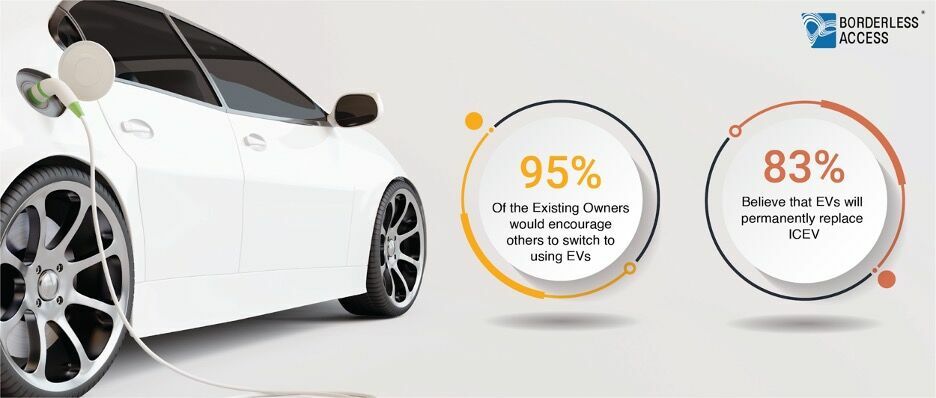
However, there is still a long way to go before witnessing a complete shift to electric vehicles. Manufacturers are attempting to address concerns about charging infrastructure and mileage. Charging infrastructure in some markets has certainly improved in recent years, which has been critical in the positive shift in EV adoption.
55% of the potential buyers think that the improvement rate of charging infrastructure is slow which consequently may impact the adoption rate.
The government, too, can play an important role in promoting EVs and boosting the adoption rate. Federal incentives are essentially rewards for people who make an effort to clean up the environment.
For 56% of the existing EV owners, government subsidies played a significant role in their purchase decision. Interestingly, 42% of the intenders feel that the current incentive scheme should be improved to encourage them to make a purchase.
Collaboration between local governments and businesses can aid in determining the best strategy for EV charging station locations. By ensuring that the appropriate charging infrastructure is in place, one can ensure that their and the public's money is being spent wisely, facilitating the increased uptake of EVs.
Conclusion
To address raging environmental concerns and fluctuating fuel prices, the world appears ready to transition to electric vehicles. The environment is not the only advantage of EVs. They are also cost-effective to operate and maintain. Nevertheless, the path to complete transition has several impediments.
The increasing demand for EVs is an opportunity to invest in EV infrastructure and consumer engagement. The top reasons for slow EV adoption are poor drive range due to limited battery capacity, the cost versus benefit, and lack of adequate charging infrastructure. If these concerns are not addressed in a timely and appropriate manner, they can hurt potential consumers' purchase decisions.
Anshul Agarwal
Associate Director – Global Marketing & Brand at Borderless AccessAnshul is a seasoned marketer with over 12 years of experience in B2B-B2C marketing, digital, brand growth, sales, and product marketing. At Borderless Access, he heads the brand & marketing function globally, driving the companies efforts to empower its clients with actionable insights using innovative technology-driven methods, digital consumer access, and analytics, for driving purpose & sustainable growth.


